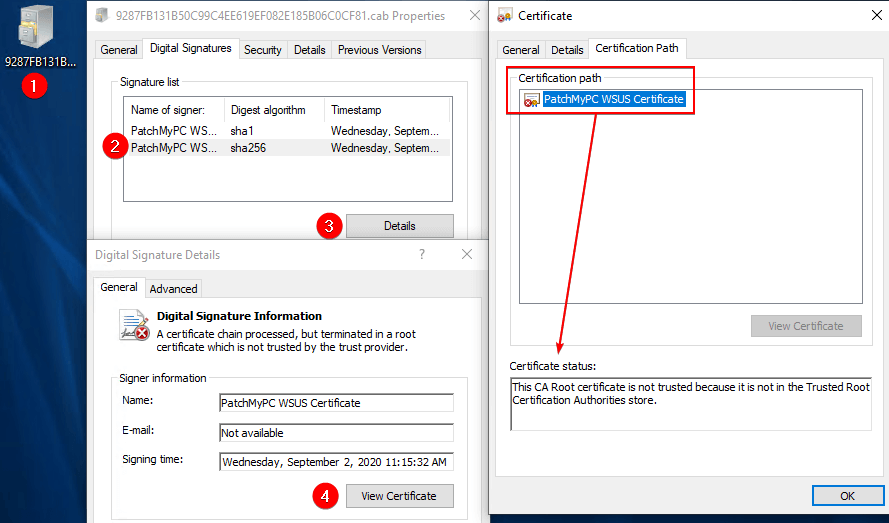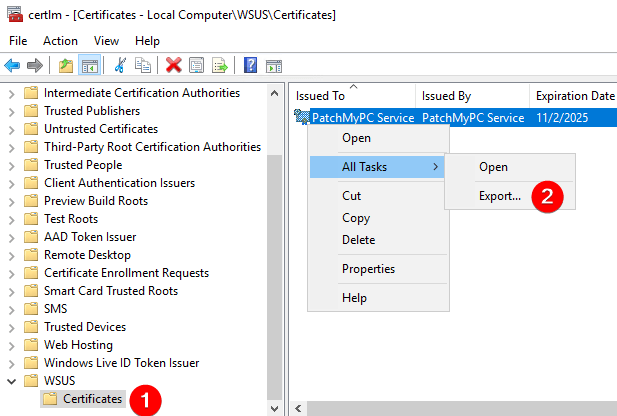We’ve recently seen an increase in customer cases where published third-party software update (.CAB files) are automatically deleted from the WSUSContent folder. For this scenario, it occurs when customers are using a shared SUSDB among multiple WSUS servers.
Determine if You are Affected
The first step to determine if this could be your issue is to check if you have multiple WSUS servers (Software Update Points in ConfigMgr) using the same SUSDB. The most accurate way to check if multiple servers are using the same SUSDB is to connect to the SUSDB using SQL Server Management Studio.
Once connected, run the following SQL commands:
Use SUSDB
exec spGetFrontEndServers
The result of this query should list all WSUS front end servers using the same SUSDB.

If there aren’t multiple servers listed in the ServerName column, this blog post will not be related to your issue.
If affected, you will see .CAB updates automatically be deleted right after the publishing is completed. In many cases, this will happen so fast you will not see the file appear unless you run Procmon to verify it was created. You will likely only see a new folder created in the WSUSContent directory that is empty, and the third-party update will fail to download to a deployment package with error 404.

Why the Third-Party Update CAB Files are Auto-Deleting
If this is your scenario, we’ll dig into our findings after working with multiple customers having this same issue. The big thing to note when using a shared SUSDB with multiple WSUS servers is what WSUS server is acting as the NLBMasterFrontEndServer. From a third-party update perspective, the NLBMasterFrontEndServer is the WSUS server that performs hash validation after a third-party software update is published to the WSUSContent folder.
WSUS has a stored procedure (spUpdateServerHealthStatus) that will automatically change the WSUS server that holds the NLBMasterFrontEndServer role if the current NLBMasterFrontEndServer server has been unavailable for 5 minutes. This includes the server being offline, WSUS service stopped, or database connectivity issues.
To determine what WSUS front end server currently holds the NLBMasterFrontEndServer role, you can run the following query against the SUSDB.
select * from tbReference
In the example below, we can see the NLBMasterFrontEndServer is set to SITESYSTEM.CONTOSO.LOCAL. The publishing of updates is being performed from the WSUS server DEMO4.CONTOSO.LOCAL, because it is the top-level software update point within our Configuration Manager environment.

The root cause for the actual .CAB files being deleted is because the NLBMasterFrontEndServer server doesn’t trust the WSUS signing certificate from the WSUS server that is performing the publishing of third-party updates.
Within the WSUS log file (C:\Program Files\Update ServicesLogFilesSoftwareDistribution.log) on the NLBMasterFrontEndServer (SITESYSTEM.CONTOSO.LOCAL in our scenario), you will actually be able to see the CAB files being deleted.
CabUtilities.CheckCertificateSignature File cert verification failed for demo4j$WSUS\WsusContent7E88A3263D0FBFB63F57D93A0322958B051B18B97E.cab with 2148204809
ContentSyncAgent.WakeUpWorkerThreadProc Importing file 88A3263D0FBFB63F57D93A0322958B051B18B97E failed at file cert verification
ContentSyncAgent.WakeUpWorkerThreadProc Invalid file deleted: demo4j$WSUS\WsusContent7E88A3263D0FBFB63F57D93A0322958B051B18B97E.cab
The error code 2148204809 mentioned in the log above translates to A certificate chain processed, but terminated in a root certificate which is not trusted by the trust provider.
How to Resolve CAB File Auto-Deletion for Third-Party Updates
The previous section gives insight into the root cause of the issue which is the NLBMasterFrontEndServer doesn’t trust the WSUS Signing Certificate from the WSUS server performing the publishing. The fix is to export the WSUS Signing Certificate from the server performing the publishing and install it in the Trusted Root and Trusted Publishers certificate store on the NLBMasterFrontEndServer WSUS server.
If are using the Patch My PC Publisher, you can export the WSUS Signing Certificate from the general tab to a (.CER file).

If you are not using the Publisher, you can export the WSUS Signing Certificate using the following steps:
- Open certlm.msc on the WSUS server performing the publishing
- Click the WSUS store
- Right-click the WSUS Signing Certificate > All Tasks > Export =
- In the Export Private Key dialog, be sure to choose the option “No, do not export the private key“
Copy the (.CER certificate file) from the WSUS server that it was exported from (DEMO4.CONTOSO.LOCAL in our case) to the NLBMasterFrontEndServer (SITESERVER.CONTOSO.LOCAL in our case). On the NLBMasterFrontEndServer WSUS server, open the (.CER certificate file). In the Certificate Path tab, you will likely see the certificate shows an error similar to the one below:

On the General tab of the certificate, click Install Certificate… button

In the Certificate Import Wizard choose Local Machine for the Store Location

Click the radio button Place all certificates in the following store and browse to Trusted Root Certification Authorities

Once installed to Trusted Root Certification Authorities, repeat the certificate installation steps above, but choose the certificate store Trusted Publishers

Important: The WSUS Signing Certificate must be installed at both the Trusted Root Certification Authorities and Trusted Publishers
Once the WSUS Signing Certificate is installed on the NLBMasterFrontEndServer WSUS server, any future published updates should not be automatically deleted.

For any third-party update (.CAB files) that have already been deleted, you will need to republish those products as new updates using the article When and How to Republish Patch My PC Third-Party Updates
Note: The WSUS Signing Certificate should be installed on all devices in your environment. You can review our guide How to Deploy the WSUS Signing Certificate for Third-Party Software Updates for information on deploying the WSUS Signing Certificate site-wide.

